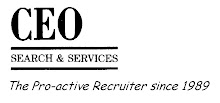ST Recruit on September 3, 1999
by ONG Yong Hwee
...unless you've also used the Twin Approach of handwriting analysis and referencing in your selection process
A Princeton University study found that for every five people hired for a particular job, four are wrong for it.
In sales, 85 per cent of employees leave their jobs - either by resignation or termination - within three months of getting hired.
Successful recruitment is a much more complex process than the matching of a candidate's academic and work experience to the position's requirements.
After all, it's not what we know but rather what we don't know about candidates that cause mis-hires.
Dr William Swan, a US management expert, introduced an interesting model in his book. How to Pick the Right People, (published by John Wiley & Sons).
It looked into the following three broad fit factors:
· The Can-Do factor analyses the candidate's knowledge, skills and abilities. This includes work experience, education, technical, analytical and communication skills, and specialised training.
These can be obtained through face-to-face interviews and appropriate technical tests.
· The Will-Do factor covers the behavioural aspects of the candidate, such as motivation, interests, goals, drive, honesty, reliability and initiative.
· The Can-fit factor covers team orientation, independence, social effectiveness, stress tolerance and other limitations.
Will-Do and Can-Fit factors are not easily determined by direct interviews.
Some employers rely on general volunteered information from references provided by candidates. Often, a lot of details are not revealed during this referencing.
But take heart, a better recruitment analysis model exists.
Twin Approach
This combines handwriting analysis and character reference checks.
It minimises job mismatches and job hopping, and helps to increase a company's chances of
hiring the most appropriate candidates.
It does not purport to replace the usual hiring processes, like face-to-face interviews.
However, used togetherwith such traditional methods, it can save precious time and money as
well as improve staff morale.
Let's look at each one in detail.
· Handwriting analysis tool:
In many European countriesand increasingly in the US, handwriting analysis is utilised as part of the screening tests prior to hiring.
It is a good, scientific and non-discriminatory method of determining the character of the candidate.
Using handwriting analysis, an in-depth understanding of the candidate's personality profile, including his personal dynamics, interpersonal skills, work style and motivating forces, can be determined to analyse Will-Do and Can-Fit factors with relative accuracy:
· Personality assessment and reference checking:
With background information from the ,handwriting analysis, you then engage in the next important step of reference checking specific attributes.
The candidate's key weaknesses and strengths can be confirmed through careful reference checking with his ex-colleagues, clients and associates.
This way, an accurate picture of the candidate can be formed and a decision to hire can be made more easily.
Article by Ong Yong Hwee, general manager of CEO Search & Services.
A Princeton University study found that for every five people hired for a particular job, four are wrong for it.
In sales, 85 per cent of employees leave their jobs - either by resignation or termination - within three months of getting hired.
Successful recruitment is a much more complex process than the matching of a candidate's academic and work experience to the position's requirements.
After all, it's not what we know but rather what we don't know about candidates that cause mis-hires.
Dr William Swan, a US management expert, introduced an interesting model in his book. How to Pick the Right People, (published by John Wiley & Sons).
It looked into the following three broad fit factors:
· The Can-Do factor analyses the candidate's knowledge, skills and abilities. This includes work experience, education, technical, analytical and communication skills, and specialised training.
These can be obtained through face-to-face interviews and appropriate technical tests.
· The Will-Do factor covers the behavioural aspects of the candidate, such as motivation, interests, goals, drive, honesty, reliability and initiative.
· The Can-fit factor covers team orientation, independence, social effectiveness, stress tolerance and other limitations.
Will-Do and Can-Fit factors are not easily determined by direct interviews.
Some employers rely on general volunteered information from references provided by candidates. Often, a lot of details are not revealed during this referencing.
But take heart, a better recruitment analysis model exists.
Twin Approach
This combines handwriting analysis and character reference checks.
It minimises job mismatches and job hopping, and helps to increase a company's chances of
hiring the most appropriate candidates.
It does not purport to replace the usual hiring processes, like face-to-face interviews.
However, used togetherwith such traditional methods, it can save precious time and money as
well as improve staff morale.
Let's look at each one in detail.
· Handwriting analysis tool:
In many European countriesand increasingly in the US, handwriting analysis is utilised as part of the screening tests prior to hiring.
It is a good, scientific and non-discriminatory method of determining the character of the candidate.
Using handwriting analysis, an in-depth understanding of the candidate's personality profile, including his personal dynamics, interpersonal skills, work style and motivating forces, can be determined to analyse Will-Do and Can-Fit factors with relative accuracy:
· Personality assessment and reference checking:
With background information from the ,handwriting analysis, you then engage in the next important step of reference checking specific attributes.
The candidate's key weaknesses and strengths can be confirmed through careful reference checking with his ex-colleagues, clients and associates.
This way, an accurate picture of the candidate can be formed and a decision to hire can be made more easily.
Article by Ong Yong Hwee, general manager of CEO Search & Services.
This article first appeared in ST Recruit on September 3, 1999.


No comments:
Post a Comment